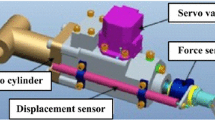Abstract
The system considered in this work consists of a cylinder which is controlled by a pair of three-way servo valves rather than a four-way one. Therefore, the cylinder output stiffness is independently controllable of the output force. A discontinuous projection based adaptive robust controller (ARC) was constructed to achieve high-accuracy output force trajectory tracking for the system. In ARC, on-line parameter adaptation method was adopted to reduce the extent of parametric uncertainties due to the variation of friction parameters, and sliding mode control method was utilized to attenuate the effects of parameter estimation errors, unmodelled dynamics and disturbance. Furthermore, output stiffness maximization/minimization was introduced to fulfill the requirement of many robotic applications. Extensive experimental results were presented to illustrate the effectiveness and the achievable performance of the proposed scheme. For tracking a 0.5 Hz sinusoidal trajectory, maximum tracking error is 4.1 N and average tracking error is 2.2 N. Meanwhile, the output stiffness can be made and maintained near its maximum/minimum.
Similar content being viewed by others
References
BOBROW J E, McDONELL B W. Modeling, identification, and control of a pneumatically actuated, force controllable robot [J]. IEEE Transaction on Robotics and Automation, 1998, 14(5): 732–742.
TAGHIZADEH M, NAJAFI F, GHAFFARI A. Multimodel PD-control of a pneumatic actuator under variable load [J]. International Journal of Advanced Manufacturing Technology, 2010, 48(5/8): 655–662.
WOLBRECHT E T, REINKENSMEYER D J, BOBROW J E. Pneumatic control of robots for rehabilitation [J]. The International Journal of Robotics Research, 2010, 29(1): 23–28.
BEN-DOV D, SALCUDEAN S. A force controlled pneumatic actuator [J]. IEEE Transaction on Robotics and Automation, 1995, 11(6): 906–911.
RICHER E, HURMUZLU Y. A high performance pneumatic force actuator system, part 1-nonlinear mathematical model [J]. Journal of Dynamic Systems, Measurement, Control, 2000, 122(3): 416–425.
RICHER E, HURMUZLU Y. A high performance pneumatic force actuator system, Part 2: Nonlinear controller design [J]. Journal of Dynamic Systems, Measurement, Control, 2000, 122(4): 426–434.
ZHU Y, BARTH E. Impedance control of a pneumatic actuator for contact tasks [C]// Proc of the IEEE International Conference on Robotics and Automation. Barcelona, Spain: IEEE, 2005: 987–992.
KHAYATI K, BIGRAS P, DESSAINT L A. Force control loop affected by bounded uncertainties and unbounded inputs for pneumatic actuator systems [J]. Journal of Dynamic Systems, Measurement, Control, 2008, 130(1): 0110071–01100719.
KAITWANIDVILAI S, PARNICHKUN M. Force control in a pneumatic system using hybrid adaptive neuro-fuzzy model reference control [J]. Mechatronics, 2004, 15(1): 23–41.
SHEN X, GOLDFARB M. Simultaneous force and stiffness control of a pneumatic actuator [J]. Journal of Dynamic Systems, Measurement, Control, 2007, 129(4): 425–434.
YAO B. High performance adaptive robust control of nonlinear systems: A general framework and new schemes [C]// Proc of the 36th Conference on Decision and Control. San Diego, USA: IEEE Press, 1997: 2489–2494.
YAO B, TOMIZUKA M. Adaptive robust control of SISO nonlinear systems in semi-strict feedback form [J]. Automatica, 1997, 33(5): 893–890.
YAO B, BU F, REEDY J, CHIU G. Adaptive robust motion control of single-rod hydraulic actuators: Theory and experiments [J]. IEEE/ASME Transactions on Mechatronics, 2000, 5(1): 79–91.
XU L, YAO B. Adaptive robust precision motion control of linear motors with negligible electrical dynamics: Theory and experiments. IEEE/ASME Transactions on Mechatronics, 2001, 6(4): 444–452.
ZHU Xiao-cong, TAO Guo-liang, YAO B, CAO Jian. Adaptive robust posture control of a parallel manipulator driven by pneumatic muscles [J]. Automatica, 2008, 44(9): 2248–2257.
MENG De-yuan, TAO Guo-liang, CHEN Jian-feng, BAN Wei. Modeling of a pneumatic system for high-accuracy position control [C]//International Conference on Fluid Power and Mechatronics, Beijing, China: IEEE Press, 2011: 505–510.
ARMSTRONG B, DUPONT P, CANUDAS C. A survey of models, analysis tools and compensation methods for the control of machines with friction [J]. Automatica, 1994, 30(7): 1083–1138.
CANUDAS C, LISCHINSKY P. Adaptive friction compensation with partially known dynamic friction model [J]. International Journal of Adaptive Control and Signal Processing, 1997, 11(1): 65–80.
SALEEM A, ABDRABBO S, TUTUNJI T. On-line identification and control of pneumatic servo drives via a mixed-reality environment [J]. International Journal of Advanced Manufacturing Technology, 2009, 40(5/6): 518–530.
CAMEIRO J, ALMEIDA F. Heat transfer evaluation on industrial pneumatic cylinders [J]. Journal of Systems and Control Engineering, 2007, 221(1): 119–128.
Author information
Authors and Affiliations
Corresponding author
Additional information
Foundation item: Projects(50775200, 50905156) supported by the National Natural Science Foundation of China
Rights and permissions
About this article
Cite this article
Meng, Dy., Tao, Gl., Ban, W. et al. Adaptive robust output force tracking control of pneumatic cylinder while maximizing/minimizing its stiffness. J. Cent. South Univ. 20, 1510–1518 (2013). https://doi.org/10.1007/s11771-013-1642-4
Received:
Accepted:
Published:
Issue Date:
DOI: https://doi.org/10.1007/s11771-013-1642-4




